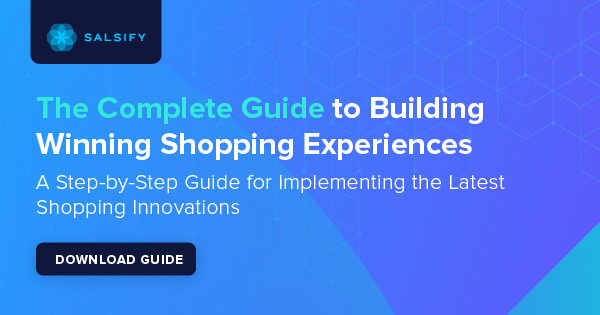The retail industry has undergone its fair share of upheavals in the past few years, and the effects of those changes are still being felt today. From the shockwaves of the COVID-19 pandemic to the innovations introduced by new technologies, retail is poised for ongoing evolution.
In the face of all this change — and with the added complications of an uncertain economy — retailers need to be aware of all the newest trends and technologies in the industry.
Many of the most prominent retail trends of past years have grown in importance, while others have faded in the face of new technology or industry developments that are expected to shape the future.
Here’s an overview of some of the most important trends in retail to keep your eye on.
Innovative Tech Is Reshaping How Consumers Find and Evaluate Products
Technological innovations have been reshaping the retail industry at a near-constant pace for the past couple of decades, and this rate of change is only increasing. Brands and retailers who don’t keep pace with innovation in the coming years are at risk of falling behind.
Voice search is already playing a prominent role in tech trends in retail. Currently, nearly a third (30%) of ecommerce shoppers use voice search to track packages and almost a quarter (20%) use it to leave product reviews. It’s now important that retailers index their pages for voice so they can take advantage of this growing approach to search.
Augmented reality (AR) is another relatively new technology that’s already being used to enhance the shopping experience both online and in-person.
From offering virtual fitting rooms to crafting interactive in-store displays, brands and retailers are finding innovative ways to use AR to foster consumers’ enthusiasm about shopping and help them envision what it’s like to own a product.
Related to AR is virtual reality (VR), a technology that allows users to become fully immersed in a digital world. VR for retail isn’t quite ready yet, but it will likely be part of the retail landscape sooner than expected, and forward-looking retailers and brands are already investing in the metaverse, notes TechRepublic.
Shopping Directly on Social Media Is Becoming More Common
Social commerce is already one of the most significant new trends in retail, and its impact is poised to grow. According to Emarketer, social commerce sales in the U.S. are expected to grow to a staggering $1,223.7 billion by 2027.
Consumers’ willingness to buy directly from social media platforms has jumped dramatically in recent years. The fastest-growing platform for social commerce is TikTok, which draws shoppers in droves. According to JungleScout, a third of online shoppers browse TikTok once a week and a quarter have previously bought a product on the platform. Other leading platforms for social commerce include YouTube, Facebook, and Instagram.
Related to social commerce is livestream shopping, which is already massively successful in East Asian markets. A 2020 Taobao stream earned $7.5 billion in just the first 30 minutes of the event, according to the South China Morning Post. Expect to see livestream shopping events pop up more often in the west as global brands recognize its potential.
The Lines Between Online and In-Store Shopping Are Continuing To Blur
The ecommerce boom initiated by the pandemic isn’t stopping any time soon. Statista predicts that the U.S.-based ecommerce market will hit $3.178 billion in 2024 and will continue to grow annually by 9.47% by 2029.
Though ecommerce is growing, growth is slowing as shoppers return to some of their pre-pandemic shopping habits. Consumers have become accustomed to the convenience of ecommerce, but, at the same time, many want the experiences provided by in-store shopping.
Successful brands and retailers cater to both of these desires.
Embracing omnichannel commerce will continue to be imperative. For example, consumers have shown a desire to be able to buy online, pick up in-store (BOPIS), and buy online, return in-store (BORIS), blurring the lines between digital and physical commerce.
As noted by GlobeNewswire, the global BOPIS market is expected to reach $703.18 billion by 2027, growing by nearly 20% each year from 2021 to 2027.
Consumers expect there to be no friction as they move between digital and in-person browsing, buying, and returning. Retailers and brands need to update their approaches to inventory, product presentation, and more to create a seamless omnichannel experience.
In-Store Automation Is Becoming Widespread
According to a multiyear Insiciv study, retailers are expected to automate 70% of their routine tasks by 2025.
This move toward automation will include investments in technologies that use artificial intelligence (AI) for necessary functions like customer service. It will also be seen inside brick-and-mortar stores as contactless payments and self-checkouts become increasingly common.
Autonomous shopping is a technology trend that takes in-store automation one step further by using AI to create cashier-free stores. While it sounds futuristic, MS Dynamics World reports that industry leaders predict staff-free stores will become common within the next few years.
Automation can be a strategic approach for retailers struggling with the labor shortage or looking to give consumers the seamless convenience they expect from online shopping.
More Consumers Are Prioritizing Sustainability
As climate change becomes more prominent in the news, sustainability will become an increasingly important factor for shoppers’ buying choices.
A Capgemini survey found that 79% of global consumers are changing their purchase preferences based on sustainability, and 66% have chosen to purchase products based on their environmental friendliness.
Environmental awareness is especially prominent among Generation Z (Gen Z) and millennial consumers, with 72% of respondents between ages 25 to 35 saying that they feel happy when buying sustainable products (compared to 64% overall).
Brands and retailers have the potential to foster greater consumer satisfaction and loyalty over time by embracing sustainability in their packaging, supply chains, and operations — and communicating their efforts.
Personalized Experiences Are Driving Conversions
Consumers today are bombarded with products, purchasing options, and marketing materials on nearly every digital platform they open. What makes an online shopper choose one product over another in such a saturated market? Personalization and relevance.
Salsify’s “2024 Consumer Research” report found that personalized brand or product recommendations were the second-most important thing shoppers sought in their AI-powered shopping experiences.
Detailed and enhanced product content like images, videos, or demonstrations also drives shoppers to click “buy” — especially when that content speaks to their unique needs.
Creating personalized shopping experiences starts with understanding your customers. Brands and retailers that collect and analyze buyer behavioral data, cookie-based browsing data, and other insights are better able to tap into — and deliver — exactly what their consumers want.
Stay Ahead of Trends in Retail
Innovative technologies able to meet evolving consumer demands are expected to define the retail environment in the next few years.
Ecommerce will continue to grow while, at the same time, modernized in-store experiences and seamless omnichannel shopping will become critical to consumer satisfaction.
The ripple effects of global events — including the labor shortage and the push for sustainability — will also impact how retailers operate over the coming years.
Ultimately, the brands and retailers that succeed in this changing world are those who can provide winning shopping experiences that evolve alongside consumers’ needs and expectations.

2024 CONSUMER RESEARCH REPORT
Download the report for more retail trends and other insider tips to win over consumers.
DOWNLOAD NOW
Want To Win in Retail?
If you're curious about more trends in retail and other insider tips to win over consumers, download “The Complete Guide to Building Winning Shopping Experiences.”
DOWNLOAD GUIDE
Tag(s):
Written by: Nicole D'Angelo
Nicole D’Angelo (she/her) is a freelance writer, editor, and content marketer with over eight years of experience creating content for various industries. Previously, she managed content production for business-to-business (B2B) and business-to-consumer (B2C) brands, including Fortune 500 companies.
Recent Posts
Ecommerce Marketing
|
12 minute read
The Art of the Impulse Buy: 70% of Shoppers Say Discounts Drive Unplanned Purchases — Here’s Why
Read More
Ecommerce Marketing
|
10 minute read
What Does It Take To Have a Good Brand Reputation in 2025?
Read More
Ecommerce Trends
|
11 minute read
What Is Commerce Media — and How Can It Optimize Your Marketing Spend?
Read More
Subscribe to the Below the Fold Newsletter
Standing out on the digital shelf starts with access to the latest industry content. Subscribe to Below the Fold, our monthly content newsletter, and join other commerce leaders.
2024 CONSUMER RESEARCH REPORT
Download the report for more retail trends and other insider tips to win over consumers.
DOWNLOAD NOW
GUIDE: The Complete Guide To Building Winning Shopping Experiences
Download this step-by-step guide for implementing the latest shopping innovations.
DOWNLOAD GUIDE


.svg)